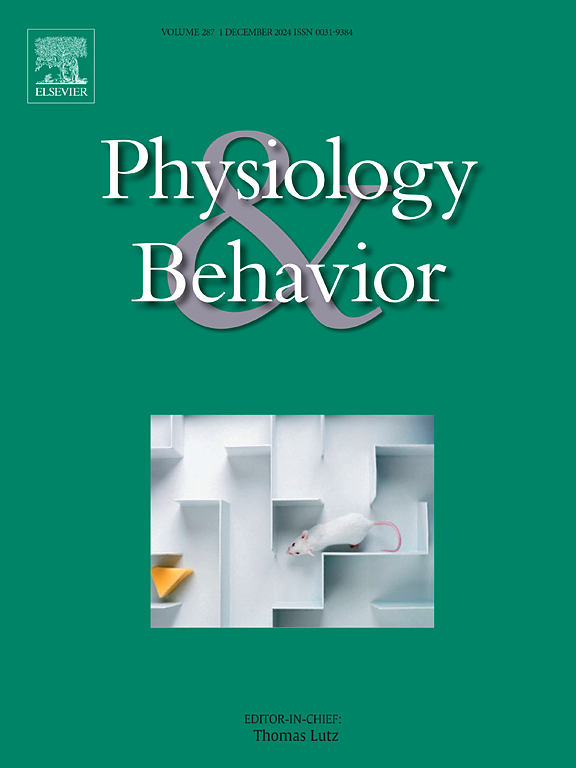Repeated balance exercise promotes cholinergic neuroprotection of the pedunculopontine nucleus in a progressive model of Parkinson's disease
IF 2.4
3区 医学
Q2 BEHAVIORAL SCIENCES
引用次数: 0
Abstract
Vestibular rehabilitation (VR) is a therapeutic approach that minimizes the impacts of balance alterations by enhancing the central vestibular compensation mechanism. The present study investigates the effect of repeated balance exercises on the central vestibular compensation mechanism in a reserpine-induced progressive model of parkinsonism in aged rats. Male Wistar rats were assigned to three cohort experiments: Exp 1: repeated balance exercises (narrow beam test) – performed every 48 h during 20 days; Exp 2: balance exercises performed on the 0th and 8th days; Exp 3: balance exercises performed only on the 0th and 20th days. For each experiment, the animals were divided into two groups (n = 7 per group): CTL (vehicle) and RES (reserpine 0.1 mg/kg). The animals received 4 (exp. 2) or 10 (exp 1 and 3) s.c. injections (0.1 mg/kg), one every 48 h. The cohorts were evaluated using catalepsy and open field tests (0th, 8th and 20th days). After completion of behavioral tests, the brains were analyzed for immunohistochemistry for tyrosine hydroxylase (TH) and choline acetyltransferase (ChAT). The RES group presented motor deficits in the catalepsy and open field tests on day 20, but not on day 8. There was no decrease in the number of TH neurons and terminals in the substantia nigra pars compacta (SNpc), ventral tegmental area (VTA) and dorsal striatum (DS) for animals from Exp. 2. However, a decrease was observed in the SNpc, VTA and striatum of animals from Exp 1 and Exp 3. In the balance beam test, the animals in the RES group showed a longer crossing time from day 8 to day 14 (Exp 1), on the 8th day (Exp 2) and on the 20th day (Exp. 3). This finding was correlated with a decrease in the number of ChAT immunoreactive cells in the pedunculopontine tegmental nucleus (PPN) for the animals that performed the dynamic balance test only once (Exp. 2 and 3), but no reduction was observed in the animals that performed the test repeatedly (Epx. 1). Thus, it was possible to verify that repeated exposure of the animals to balance assessment tasks potentiated the performance of the central vestibular compensation mechanism in the animal model of parkinsonism.
在渐进性帕金森病模型中,重复平衡运动可促进足底核的胆碱能神经保护。
前庭康复(VR)是一种治疗方法,它通过增强中枢前庭补偿机制来最大限度地减少平衡改变的影响。本研究探讨了在利血平诱导的渐进性帕金森病模型中,重复平衡练习对老年大鼠中枢前庭补偿机制的影响。雄性 Wistar 大鼠被分配到三个队列实验中:实验 1:重复平衡练习(窄梁测试)--在 20 天内每 48 小时进行一次;实验 2:在第 0 天和第 8 天进行平衡练习;实验 3:仅在第 0 天和第 20 天进行平衡练习。每次实验将动物分为两组(每组 n = 7):CTL(载体)和 RES(瑞舍平 0.1 毫克/千克)。动物接受 4 次(实验 2)或 10 次(实验 1 和 3)静脉注射(0.1 毫克/千克),每 48 小时一次。在第 0 天、第 8 天和第 20 天对动物进行了催眠和开阔地测试评估。行为测试结束后,对大脑进行酪氨酸羟化酶(TH)和胆碱乙酰转移酶(ChAT)免疫组化分析。RES 组在第 20 天的催眠和开阔地测试中出现运动障碍,而在第 8 天则没有。实验 2 动物的黑质紧密区(SNpc)、腹侧被盖区(VTA)和背侧纹状体(DS)中的 TH 神经元和终端数量没有减少。在平衡木测试中,RES组动物从第8天到第14天(实验1)、第8天(实验2)和第20天(实验3)的穿越时间较长。这一发现与只进行了一次动态平衡试验(试验 2 和试验 3)的动物足底部被盖核中 ChAT 免疫反应细胞数量的减少有关,但在重复进行试验(试验 1)的动物中没有观察到减少。因此,在帕金森氏症动物模型中,重复接触平衡评估任务可以增强中枢前庭补偿机制的功能。
本文章由计算机程序翻译,如有差异,请以英文原文为准。
求助全文
约1分钟内获得全文
求助全文
来源期刊

Physiology & Behavior
医学-行为科学
CiteScore
5.70
自引率
3.40%
发文量
274
审稿时长
47 days
期刊介绍:
Physiology & Behavior is aimed at the causal physiological mechanisms of behavior and its modulation by environmental factors. The journal invites original reports in the broad area of behavioral and cognitive neuroscience, in which at least one variable is physiological and the primary emphasis and theoretical context are behavioral. The range of subjects includes behavioral neuroendocrinology, psychoneuroimmunology, learning and memory, ingestion, social behavior, and studies related to the mechanisms of psychopathology. Contemporary reviews and theoretical articles are welcomed and the Editors invite such proposals from interested authors.
 求助内容:
求助内容: 应助结果提醒方式:
应助结果提醒方式:


